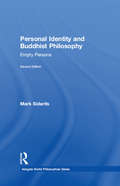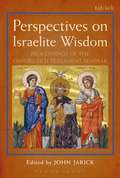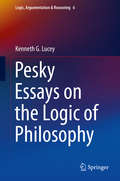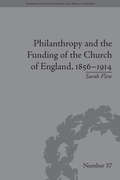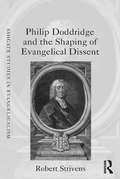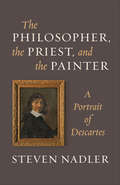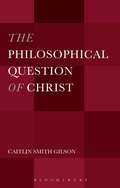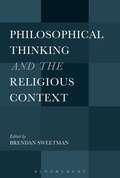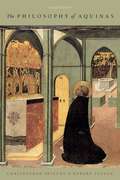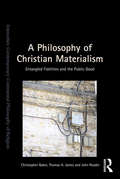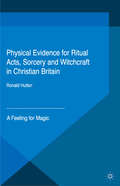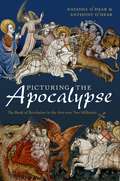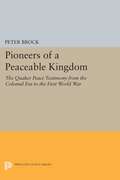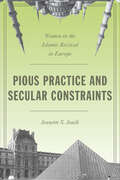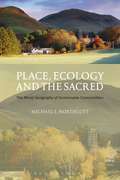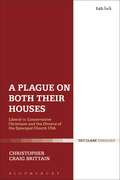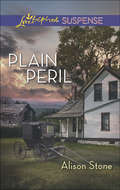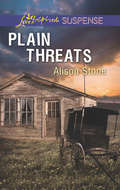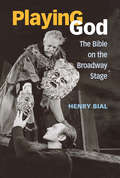- Table View
- List View
Personal Identity and Buddhist Philosophy: Empty Persons (Ashgate World Philosophies Series)
by Mark SideritsSince the publication of Mark Siderits' important book in 2003, much has changed in the field of Buddhist philosophy. There has been unprecedented growth in analytic metaphysics, and a considerable amount of new work on Indian theories of the self and personal identity has emerged. Fully revised and updated, and drawing on these changes as well as on developments in the author's own thinking, Personal Identity and Buddhist Philosophy, second edition explores the conversation between Buddhist and Western Philosophy showing how concepts and tools drawn from one philosophical tradition can help solve problems arising in another. Siderits discusses afresh areas involved in the philosophical investigation of persons, including vagueness and its implications for personal identity, recent attempts by scholars of Buddhist philosophy to defend the attribution of an emergentist account of personhood to at least some Buddhists, and whether a distinctively Buddhist antirealism can avoid problems that beset other forms of ontological anti-foundationalism.
Perspectives on Israelite Wisdom: Proceedings of the Oxford Old Testament Seminar (The Library of Hebrew Bible/Old Testament Studies #618)
by John JarickThis collection of essays examines the wisdom traditions of the Old Testament from a variety of angles. The slipperiness of the concept of 'wisdom literature', the transmission of 'wise' advice for living, rabbinic and patristic approaches to the Bible's wisdom traditions, and cutting-edge modern perspectives on such Old Testament books as Proverbs, Job, and Ecclesiastes are all to be found here.In the tradition of the renowned previous volumes from the Oxford Old Testament Seminar - King and Messiah in Israel and the Ancient Near East (1998), In Search of Pre-Exilic Israel (2004), Temple and Worship in Biblical Israel (2005), and Prophecy and Prophets in Ancient Israel (2010)-this new volume again brings the scholarship of the Oxford Seminar, here focused on the rich subject of Old Testament wisdom traditions, to an international readership.
Pesky Essays on the Logic of Philosophy (Logic, Argumentation & Reasoning #6)
by Kenneth G. LuceyThis collection of essays explores the philosophy of human knowledge from a multitude of perspectives, with a particular emphasis upon the justification component of the classical analysis of knowledge and with an excursion along the way to explore the role of knowledge in Texas Hold ‘Em poker.An important theme of the collection is the role of knowledge in religion, including a detailed argument for agnosticism. A number of the essays touch upon issues in philosophical logic, among them a fascinating new counter-example to Modus Ponens. The collection is rounded out with essays on causality and the philosophy of mind.The author’s perspective on the philosophy of human knowledge is fresh and challenging, as evidenced by essays entitled “On Epistemic Preferability;” “On Being Unjustified;” “The Logic of ‘Unless’” and “Is ‘This sentence is true.’ True?”An interesting feature of The Logic of Philosophy: Pesky Essays is the inclusion of responses to several of its key essays, contributed by such prominent contemporary philosophers as Roderick Chisholm, Ted Sider and Tomas Kapitan.
Philanthropy and the Funding of the Church of England, 1856–1914 (Perspectives in Economic and Social History)
by Sarah FlewThe changing relationship between the church and its supporters is key to understanding changing religious and social attitudes in Victorian Britain. Using the records of the Anglican Church’s home-missionary organizations, Flew charts the decline in Christian philanthropy and its connection to the growing secularization of society.
Philanthropy and the Funding of the Church of England, 1856–1914 (Perspectives in Economic and Social History #37)
by Sarah FlewThe changing relationship between the church and its supporters is key to understanding changing religious and social attitudes in Victorian Britain. Using the records of the Anglican Church’s home-missionary organizations, Flew charts the decline in Christian philanthropy and its connection to the growing secularization of society.
Philip Doddridge and the Shaping of Evangelical Dissent (Routledge Studies in Evangelicalism)
by Robert StrivensEvangelical Dissent in the early eighteenth century had to address a variety of intellectual challenges. How reliable was the Bible? Was traditional Christian teaching about God, humanity, sin and salvation true? What was the role of reason in the Christian faith? Philip Doddridge (1702-51) pastored a sizeable evangelical congregation in Northampton, England, and ran a training academy for Dissenters which prepared men for pastoral ministry. Philip Doddridge and the Shaping of Evangelical Dissent examines his theology and philosophy in the context of these and other issues of his day and explores the leadership that he provided in evangelical Dissent in the first half of the eighteenth century. Offering a fresh look at Doddridge’s thought, the book provides a criticial examination of the accepted view that Doddridge was influenced in his thinking primarily by Richard Baxter and John Locke. Exploring the influence of other streams of thought, from John Owen and other Puritan writers to Samuel Clarke and Isaac Watts, as well as interaction with contemporaries in Dissent, the book shows Doddridge to be a leader in, and shaper of, an evangelical Dissent which was essentially Calvinistic in its theology, adapted to the contours and culture of its times.
Philip Doddridge and the Shaping of Evangelical Dissent (Routledge Studies in Evangelicalism)
by Robert StrivensEvangelical Dissent in the early eighteenth century had to address a variety of intellectual challenges. How reliable was the Bible? Was traditional Christian teaching about God, humanity, sin and salvation true? What was the role of reason in the Christian faith? Philip Doddridge (1702-51) pastored a sizeable evangelical congregation in Northampton, England, and ran a training academy for Dissenters which prepared men for pastoral ministry. Philip Doddridge and the Shaping of Evangelical Dissent examines his theology and philosophy in the context of these and other issues of his day and explores the leadership that he provided in evangelical Dissent in the first half of the eighteenth century. Offering a fresh look at Doddridge’s thought, the book provides a criticial examination of the accepted view that Doddridge was influenced in his thinking primarily by Richard Baxter and John Locke. Exploring the influence of other streams of thought, from John Owen and other Puritan writers to Samuel Clarke and Isaac Watts, as well as interaction with contemporaries in Dissent, the book shows Doddridge to be a leader in, and shaper of, an evangelical Dissent which was essentially Calvinistic in its theology, adapted to the contours and culture of its times.
The Philosopher, the Priest, and the Painter: A Portrait of Descartes
by Steven NadlerIn the Louvre museum hangs a portrait that is considered the iconic image of René Descartes, the great seventeenth-century French philosopher. And the painter of the work? The Dutch master Frans Hals--or so it was long believed, until the work was downgraded to a copy of an original. But where is the authentic version, and who painted it? Is the man in the painting--and in its original--really Descartes? A unique combination of philosophy, biography, and art history, The Philosopher, the Priest, and the Painter investigates the remarkable individuals and circumstances behind a small portrait. Through this image--and the intersecting lives of a brilliant philosopher, a Catholic priest, and a gifted painter--Steven Nadler opens a fascinating portal into Descartes's life and times, skillfully presenting an accessible introduction to Descartes's philosophical and scientific ideas, and an illuminating tour of the volatile political and religious environment of the Dutch Golden Age. As Nadler shows, Descartes's innovative ideas about the world, about human nature and knowledge, and about philosophy itself, stirred great controversy. Philosophical and theological critics vigorously opposed his views, and civil and ecclesiastic authorities condemned his writings. Nevertheless, Descartes's thought came to dominate the philosophical world of the period, and can rightly be called the philosophy of the seventeenth century. Shedding light on a well-known image, The Philosopher, the Priest, and the Painter offers an engaging exploration of a celebrated philosopher's world and work.
The Philosopher, the Priest, and the Painter: A Portrait of Descartes
by Steven NadlerIn the Louvre museum hangs a portrait that is considered the iconic image of René Descartes, the great seventeenth-century French philosopher. And the painter of the work? The Dutch master Frans Hals--or so it was long believed, until the work was downgraded to a copy of an original. But where is the authentic version, and who painted it? Is the man in the painting--and in its original--really Descartes? A unique combination of philosophy, biography, and art history, The Philosopher, the Priest, and the Painter investigates the remarkable individuals and circumstances behind a small portrait. Through this image--and the intersecting lives of a brilliant philosopher, a Catholic priest, and a gifted painter--Steven Nadler opens a fascinating portal into Descartes's life and times, skillfully presenting an accessible introduction to Descartes's philosophical and scientific ideas, and an illuminating tour of the volatile political and religious environment of the Dutch Golden Age. As Nadler shows, Descartes's innovative ideas about the world, about human nature and knowledge, and about philosophy itself, stirred great controversy. Philosophical and theological critics vigorously opposed his views, and civil and ecclesiastic authorities condemned his writings. Nevertheless, Descartes's thought came to dominate the philosophical world of the period, and can rightly be called the philosophy of the seventeenth century. Shedding light on a well-known image, The Philosopher, the Priest, and the Painter offers an engaging exploration of a celebrated philosopher's world and work.
The Philosophical Question of Christ
by Caitlin Smith GilsonDoes the figure of Christ provide philosophical reason with its ultimate philosophical challenge? What can thought as thought say about the picture of Christ in the Gospels? Gilson argues that the forgotten hermeneutic of perfection provides the key to a re-thinking of the fundamental categories of reason and faith.From a strictly philosophic perspective Gilson examines the figure of Christ in the gospels as a unique essence no longer either traceable or reducible to any contributing influences; so unique as to transcend while incorporating all comparative genera; so unique as to carry within itself not its own self-evidence but its own inescapability. The Philosophical Question of Christ examines the fundamental ideas expressed in Christianity: the idea of the Man-God, the meaning of faith, the nature of Grace, death, resurrection, sin and forgiveness. The hermeneutic of perfection discoverable pre-thematically in the Greek tragedies, exemplified in Dostoyevsky, found methodologically in Anselm, Aquinas, Pascal and Kierkegaard is discussed in its epistemological and metaphysical nature. The alternative merely philosophical faith, as exemplified in Karl Jaspers and Eric Voegelin, is discussed, analyzed and shown to be deficient, both philosophically and theologically.
Philosophical Thinking and the Religious Context
by Brendan SweetmanThis new collection covers a wide range of cutting-edge and timely questions in contemporary philosophy of religion from a rich variety of backgrounds and perspectives. The essays in the volume deal with a range of fascinating topics in the philosophy of religion such as views of God's nature in process philosophy and theology, process views compared with traditional views (such as that found in St Thomas Aquinas), teleology and purpose in human life and in the universe, religion and evolution, the problem of evil both in human experience and in the natural world, and ethical questions concerning the human road to God, and the question of human rights in pluralist, democratic states. The essays in the first section, "Approaches to God," examine the rationality of the approach to the nature of God defended in process philosophy, particularly in the work of two pioneering thinkers, Charles Hartshorne and A.N. Whitehead. The second section of the book, "Science, Evolution and God," turns to the engagement of Christian views regarding the nature of God and creation with modern developments in science and philosophy. The last section, "Philosophy of Religion and Ethics," takes up broader, more foundational questions. Santiago Sia concludes the volume with a sustained reflection on the nature of philosophy, and philosophizing, a discussion to which he brings many insights and experiences from his own academic career.
PHILOSOPHY OF AQUINAS 2E C
by Robert Pasnau Christopher ShieldsThis new and updated edition of Christopher Shields and Robert Pasnau's The Philosophy of Aquinas introduces the Aquinas' overarching explanatory framework in order to provide the necessary background to his philosophical investigations across a wide range of areas: rational theology, metaphysics, philosophy of human nature, philosophy of mind, and ethical and political theory. Although not intended to provide a comprehensive evaluation of all aspects of Aquinas' far-reaching writings, the volume presents a systematic introduction to the principal areas of his philosophy and attends no less to Aquinas' methods and argumentative strategies than to his ultimate conclusions. The authors have updated the second edition in light of recent scholarship on Aquinas, while streamlining and refining their presentation of the key elements of Aquinas' philosophy.
A Philosophy of Christian Materialism: Entangled Fidelities and the Public Good (Intensities: Contemporary Continental Philosophy of Religion)
by Christopher Baker John Reader Thomas A. JamesA Philosophy of Christian Materialism offers a new religious engagement with the public sphere via means of interdisciplinary analysis and empirical examples, developing what the authors call a Relational Christian Realism building upon interaction with contemporary Philosophy of Religion. The book argues that the current discourse on public religion is inadequate in addressing the issues now to be faced, including: material religious practice in the sphere of education; the growth of alternative political movements and the developing awareness of environmental concerns and urban social justice. Key concepts that support this strategic analysis are: entangled fidelities (the form of a materialist religious practice); the possibility of a relational Christian realism (including new developments in how we interpret key categories of doctrine including God and creation, salvation and humanity), and the post-secular public sphere (including the emerging phenomenon of postsecular rapprochement - namely the coming together of both religious and secular actors in methodologies and politics of pragmatism as well as ethical discourse for the sake of the public commons). Co-authored by theologians in both the USA and the UK, this book represents an exciting contribution to philosophy and practice of religion on both sides of the Atlantic and aspires to be sufficiently interdisciplinary to also appeal to readerships engaged in the study of modern political and social trends.
A Philosophy of Christian Materialism: Entangled Fidelities and the Public Good (Intensities: Contemporary Continental Philosophy of Religion)
by Christopher Baker John Reader Thomas A. JamesA Philosophy of Christian Materialism offers a new religious engagement with the public sphere via means of interdisciplinary analysis and empirical examples, developing what the authors call a Relational Christian Realism building upon interaction with contemporary Philosophy of Religion. The book argues that the current discourse on public religion is inadequate in addressing the issues now to be faced, including: material religious practice in the sphere of education; the growth of alternative political movements and the developing awareness of environmental concerns and urban social justice. Key concepts that support this strategic analysis are: entangled fidelities (the form of a materialist religious practice); the possibility of a relational Christian realism (including new developments in how we interpret key categories of doctrine including God and creation, salvation and humanity), and the post-secular public sphere (including the emerging phenomenon of postsecular rapprochement - namely the coming together of both religious and secular actors in methodologies and politics of pragmatism as well as ethical discourse for the sake of the public commons). Co-authored by theologians in both the USA and the UK, this book represents an exciting contribution to philosophy and practice of religion on both sides of the Atlantic and aspires to be sufficiently interdisciplinary to also appeal to readerships engaged in the study of modern political and social trends.
Physical Evidence for Ritual Acts, Sorcery and Witchcraft in Christian Britain: A Feeling for Magic (Palgrave Historical Studies in Witchcraft and Magic)
by Ronald HuttonThis volume investigates the physical evidence for magic in medieval and modern Britain, including ritual mark, concealed objects, amulets, and magical equipment. The contributors are the current experts in each area of the subject, and show between them how ample the evidence is and how important it is for an understanding of history.
Picturing the Apocalypse: The Book of Revelation in the Arts over Two Millennia
by Anthony O'Hear Natasha O'HearThe book of Revelation has been a source of continual fascination for nearly two thousand years. Concepts such as The Lamb of God, the Four Horsemen, the Seventh Seal, the Beasts and Antichrist, the Whore of Babylon, Armageddon, the Millennium, the Last Judgement, the New Jerusalem, and the ubiquitous Angel of the Apocalypse have captured the popular imagination. One can hardly open a newspaper or click on a news web site without reading about impending financial or climate change Armageddon, while the concept of the Four Horsemen pervades popular music, gaming, and satire. Yet few people know much about either the basic meaning or original context of these concepts or the multiplicity of different ways in which they have been interpreted by visual artists in particular. The visual history of this most widely illustrated of all the biblical books deserves greater attention. This book fills these gaps in a striking and original way by means of ten concise thematic chapters which explain the origins of these concepts from the book of Revelation in an accessible way. These explanations are augmented and developed via a carefully selected sample of the ways in which the concepts have been treated by artists through the centuries. The 120 visual examples are drawn from a wide range of time periods and media including the ninth-century Trier Apocalypse, thirteenth-century Anglo-Norman Apocalypse Manuscripts such as the Lambeth and Trinity Apocalypses, the fourteenth-century Angers Apocalypse Tapestry, fifteenth-century Apocalypse altarpieces by Van Eyck and Memling, Dürer and Cranach's sixteenth-century Apocalypse woodcuts, and more recently a range of works by William Blake, J. M. W. Turner, Max Beckmann, as well as film posters and stills, cartoons, and children's book illustrations. The final chapter demonstrates the continuing resonance of all the themes in contemporary religious, political, and popular thinking, while throughout the book a contrast will be drawn between those readers of Revelation who have seen it in terms of earthly revolutions in the here and now, and those who have adopted a more spiritual, otherworldly approach.
Pioneers of a Peaceable Kingdom: The Quaker Peace Testimony from the Colonial Era to the First World War
by Peter BrockExtracted from Pacifism in the United States, this work focuses on the significant contribution of the Quakers to the history of pacifism in the United States.Originally published in 1971.The Princeton Legacy Library uses the latest print-on-demand technology to again make available previously out-of-print books from the distinguished backlist of Princeton University Press. These editions preserve the original texts of these important books while presenting them in durable paperback and hardcover editions. The goal of the Princeton Legacy Library is to vastly increase access to the rich scholarly heritage found in the thousands of books published by Princeton University Press since its founding in 1905.
Pious Practice and Secular Constraints: Women in the Islamic Revival in Europe
by Jeanette S. JouiliThe visible increase in religious practice among young European-born Muslims has provoked public anxiety. New government regulations seek not only to restrict Islamic practices within the public sphere, but also to shape Muslims', and especially women's, personal conduct. Pious Practice and Secular Constraints chronicles the everyday ethical struggles of women active in orthodox and socially conservative Islamic revival circles as they are torn between their quest for a pious lifestyle and their aspirations to counter negative representations of Muslims within the mainstream society. Jeanette S. Jouili conducted fieldwork in France and Germany to investigate how pious Muslim women grapple with religious expression: for example, when to wear a headscarf, where to pray throughout the day, and how to maintain modest interactions between men and women. Her analysis stresses the various ethical dilemmas the women confronted in negotiating these religious duties within a secular public sphere. In conversation with Islamic and Western thinkers, Jouili teases out the important ethical-political implications of these struggles, ultimately arguing that Muslim moral agency, surprisingly reinvigorated rather than hampered by the increasingly hostile climate in Europe, encourages us to think about the contribution of non-secular civic virtues for shaping a pluralist Europe.
Place, Ecology and the Sacred: The Moral Geography of Sustainable Communities
by Michael S. NorthcottPeople are born in one place. Traditionally humans move around more than other animals, but in modernity the global mobility of persons and the factors of production increasingly disrupts the sense of place that is an intrinsic part of the human experience of being on earth. Industrial development and fossil fuelled mobility negatively impact the sense of place and help to foster a culture of placelessness where buildings, fields and houses increasingly display a monotonous aesthetic. At the same time ecological habitats, and diverse communities of species are degraded. Romantic resistance to the industrial evisceration of place and ecological diversity involved the setting aside of scenic or sublime landscapes as wilderness areas or parks. However the implication of this project is that human dwelling and ecological sustainability are intrinsically at odds. In this collection of essays Michael Northcott argues that the sense of the sacred which emanates from local communities of faith sustained a 'parochial ecology' which, over the centuries, shaped communities that were more socially just and ecologically sustainable than the kinds of exchange relationships and settlement patterns fostered by a global and place-blind economy. Hence Christian communities in medieval Europe fostered the distributed use and intergenerational care of common resources, such as alpine meadows, forests or river catchments. But contemporary political economists neglect the role of boundaried places, and spatial limits, in the welfare of human and ecological communities. Northcott argues that place-based forms of community, dwelling and exchange – such as a local food economy – more closely resemble evolved commons governance arrangements, and facilitate the revival of a sense of neighbourhood, and of reconnection between persons and the ecological places in which they dwell.
Place, Ecology and the Sacred: The Moral Geography of Sustainable Communities
by Michael S. NorthcottPeople are born in one place. Traditionally humans move around more than other animals, but in modernity the global mobility of persons and the factors of production increasingly disrupts the sense of place that is an intrinsic part of the human experience of being on earth. Industrial development and fossil fuelled mobility negatively impact the sense of place and help to foster a culture of placelessness where buildings, fields and houses increasingly display a monotonous aesthetic. At the same time ecological habitats, and diverse communities of species are degraded. Romantic resistance to the industrial evisceration of place and ecological diversity involved the setting aside of scenic or sublime landscapes as wilderness areas or parks. However the implication of this project is that human dwelling and ecological sustainability are intrinsically at odds. In this collection of essays Michael Northcott argues that the sense of the sacred which emanates from local communities of faith sustained a 'parochial ecology' which, over the centuries, shaped communities that were more socially just and ecologically sustainable than the kinds of exchange relationships and settlement patterns fostered by a global and place-blind economy. Hence Christian communities in medieval Europe fostered the distributed use and intergenerational care of common resources, such as alpine meadows, forests or river catchments. But contemporary political economists neglect the role of boundaried places, and spatial limits, in the welfare of human and ecological communities. Northcott argues that place-based forms of community, dwelling and exchange – such as a local food economy – more closely resemble evolved commons governance arrangements, and facilitate the revival of a sense of neighbourhood, and of reconnection between persons and the ecological places in which they dwell.
A Plague on Both Their Houses: Liberal vs. Conservative Christians and the Divorce of the Episcopal Church USA
by Christopher Craig BrittainChristopher Craig Brittain offers a wide-ranging examination of specific events within The Episcopal Church (TEC) by drawing upon an analysis of theological debates within the church, field interviews in church congregations, and sociological literature on church conflict. The discussion demonstrates that interpretations describing the situation in TEC as a culture war between liberals and conservatives are deeply flawed. Moreover, the book shows that the splits that are occurring within the national church are not so much schisms in the technical sociological sense, but are more accurately described as a familial divorce, with all the ongoing messy entwinement that this term evokes. The interpretation of the dispute offered by the book also counters prominent accounts offered by leaders within The Episcopal Church. The Presiding Bishop, Katharine Jefferts-Schori, has portrayed some opponents of her theological positions and her approach to ethical issues as being 'fundamentalist', while other 'Progressives' liken their opponents to the Tea Party movement.
A Plague on Both Their Houses: Liberal vs. Conservative Christians and the Divorce of the Episcopal Church USA
by Christopher Craig BrittainChristopher Craig Brittain offers a wide-ranging examination of specific events within The Episcopal Church (TEC) by drawing upon an analysis of theological debates within the church, field interviews in church congregations, and sociological literature on church conflict. The discussion demonstrates that interpretations describing the situation in TEC as a culture war between liberals and conservatives are deeply flawed. Moreover, the book shows that the splits that are occurring within the national church are not so much schisms in the technical sociological sense, but are more accurately described as a familial divorce, with all the ongoing messy entwinement that this term evokes. The interpretation of the dispute offered by the book also counters prominent accounts offered by leaders within The Episcopal Church. The Presiding Bishop, Katharine Jefferts-Schori, has portrayed some opponents of her theological positions and her approach to ethical issues as being 'fundamentalist', while other 'Progressives' liken their opponents to the Tea Party movement.
Plain Peril: Fugitive Trackdown Plain Peril Manhunt (Mills And Boon Love Inspired Suspense Ser.)
by Alison StoneKILLER IN AMISH COUNTRYD
Plain Threats: The Protector's Mission Plain Threats Easy Prey (Mills And Boon Love Inspired Suspense Ser.)
by Alison StoneAMISH TARGET
Playing God: The Bible on the Broadway Stage
by Henry BialWhether we regard it as the collected inscriptions of an earlier oral tradition or as the divinely authored source text of liturgical ritual, the Bible can be understood as a sacred performance text, a framework for an instructional theater that performs the shared moral and ethical values of a community. It’s not surprising, then, that playwrights have turned to the Bible as a source for theatrical adaptation. Biblical texts have inspired more than 100 Broadway plays and musicals, ranging from early spectacles like Ben-Hur (1899) to more familiar works such as Godspell and Jesus Christ Superstar. What happens when a culture’s most sacred text enters its most commercial performance venue? Playing God focuses on eleven financially and/or critically successful productions, as well as a few notable Broadway flops that highlight the difficulties in adapting the Old and New Testaments for the stage. The book is informed by both performance studies and theater history, combining analysis of play-scripts with archival research into the actual circumstances of production and reception. Biblical plays, Henry Bial argues, balance religious and commercial considerations through a complex blend of spectacle, authenticity, sincerity, and irony. Though there is no magic formula for a successful adaptation, these four analytical lenses help explain why some biblical plays thrive while others have not.
